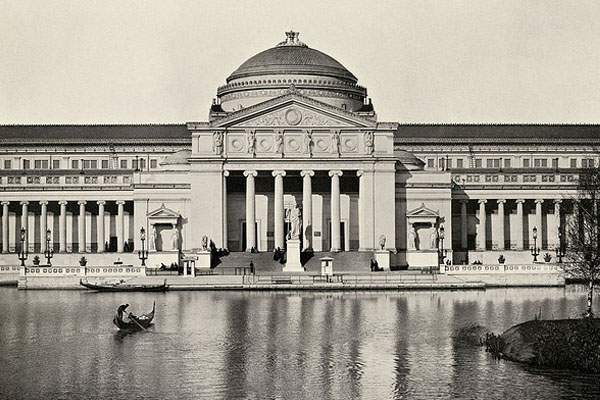
120 years ago this summer, you'd probably be spending your August figuring out what to see at the Columbian Exposition, aka, Chicago's 1893 World's Fair. It's over. But you didn't miss everything.
Today, traces of the famed White City are still all around town—there's the Chicago History Museum's Crossroads exhibit , where you can stand on the platform of El Car No. 1, built to transport Fair visitors on the city's first elevated train. Or you can take a ride on Navy Pier's Ferris Wheel and try to imagine a ride on the original—twice as tall with 36 carriages as each big as a train car, holding 60 people each.
The Museum of Science and Industry was originally the Fair's Palace of Fine Arts. And a short drive south from the MSI reveals Chicago's Golden Lady, the replica of the Columbia statue, which presided over the Fair. It's just a just over a third of the size of the original 65-footer.
Beyond those major examples, there are a few lesser known World's Fair remains hidden in the city's modern landscape. Let's take a tour:
The Auditorium Building
Most folks know the Auditorium Building and Theatre as one of Louis Sullivan's Chicago masterpieces—but, originally, it was a hotel for fair-goers Walk into what is now Roosevelt University's lobby, and the marble front desk and grand staircase transport you back to the Gilded Age.
Jackson Park's Wooded Island
Designed by landscape architect Frederick Law Olmstead, best known for creating New York's Central Park, the Wooded Island was meant to be a respite from the Fair's crowds. It still has that feeling today, with 16 acres of tower, 120 year-old trees.
Oddly enough, the bathrooms just off the Island's entrance are original to the Fair, as is the Kasuga lantern that sits outside the Japanese Garden. The Garden sits on what would have been the Fair's Japanese Ho-o-den. The original carved wooden panels from the Ho-o-den can be seen today in the Art Institute's Asian Art wing.
As for the Art Institute, the building itself was designed to later house the works that were temporarily on display at the fair. While the MSI is the only surviving onsite building, the Art Institute, originaly the World's Congress Auxillary Building, was partly paid for by Fair coffers. The building housed conventions during the time of the Fair, most notably he World Parliament of Religions, the first interfaith gathering of clergy from around the globe.
Prairie Avenue Historic District
Take a walk down Prairie avenue to see the historic row of homes once occupied by the Fair's rich backers. The street was listed as a must-see back in 1893, when famous citizens such as George Pullman and Marshall Field lived there. Today, its opulence is being restored back to what it once was.
Architecture Foundation Tours
For as complete a World's Fair experience as you can get 120 years later, the Architecture Foundation offers two tours on the subject, the Devil in the White City, and White City Revisited, where you can hear more stories of the Columbian Exposition.


